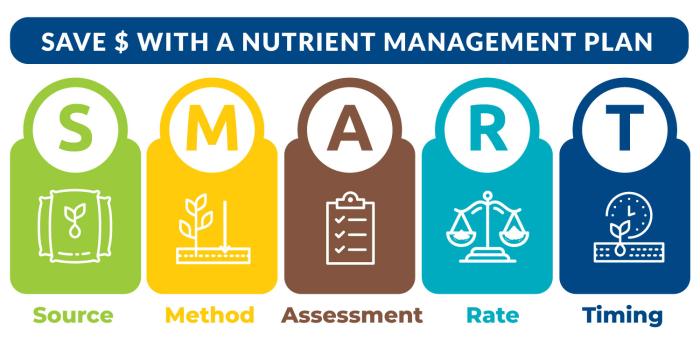
Nutrient Management is the management of nutrients and soil amendments to maximize their economic benefit while minimizing their environmental impact.
Proper nutrient management considers several factors when applying commercial fertilizers, manure, soil amendments, and organic by-products to agricultural land while also addressing associated risk of applying nutrients in protecting local air, soil, and water quality.
Nutrient Management Saves on Fertilizer Costs
Producers could be saving an average of nearly $30 per acre on fertilizer costs with a Nutrient Management Plan. Implementing a Nutrient Management Plan (Conservation Practice Standard 590) on acreage receiving excess nutrients can save anywhere from $23.77 to $49.76 per acre – that's an average of about $29.28/acre in net savings (according to data as of April 2022). It’s estimated that 89 million acres of cropland in the United States (28% of total U.S. cropland) are exceeding the nitrogen loss threshold – and if all those acres implemented a Nutrient Management Plan, then the average net savings would be $2.6 billion.
SMART Nutrient Management
A SMART Nutrient Management Plan includes the 4Rs of nutrient stewardship (the right Source, right Method, right Rate and right Timing) and emphasizes smart activities to reduce nutrient loss by Assessment of comprehensive, site-specific conditions.
Below are the factors to consider when developing a SMART Nutrient Management Plan.

Source
Farmers may apply commercial fertilizers, manure, soil amendments, or organic-by-products to provide the nutrients plants need. When determining the nutrient source that’s best for your operation, here are some things to consider:
- Best match. Choose the right nutrient sources to best match the needs of your crop and soil while minimizing the site-specific risk of nutrient loss. Needs vary depending on your local soil and climate conditions, specific crop, and conservation practices you implement such as reduced tillage, no-till, or cover crops.
- Utilization needs. Select nutrients based on your utilization needs. If you have a new planting, you may need a delayed uptake just after seed germination. Or, you may have an established crop that’s ready to take up nutrients immediately.
- Testing. Test to confirm key nutrient needs for your soil and plants. Soil tests can help you to identify the key nutrients your soil needs so you can make an informed decision on the correct fertilizer and the right quantity for your crops. Plant tissue tests can also add valuable insights. Similarly, test manure, soil amendments, or organic by-products. If you use manure or organic by-products, testing the manure for nutrient content can help meet crop nutrient needs more efficiently. This leads to increased profit and decreased risk of pollution. Testing is the most reliable way to determine what your soil and crop needs to select the best nutrient source. Testing is a key component in nutrient management planning. Contact your local extension service for more information on testing.
Method
For effective nutrient management, method of application can make all the difference. When determining how and where you apply nutrients, here are some things to consider:
- Injection. Getting nutrients down below the surface of the soil and into the root zone of your crop increases the plant’s ability to access them. Injecting nutrients is one way to deliver them exactly where they’re needed.
- Incorporation. Specific sites may require nutrients to be incorporated into the soil, not just broadcast on the surface, for plants to adequately access them and to reduce the risk of nutrient loss in runoff events. This can be true even if you practice reduced tillage or no-till. Through these systems, nutrient placement with the planter or injection via a no-till, low disturbance application tools are effective methods for nutrient incorporation. If a broadcast method is utilized, some sites may benefit from a low intensity incorporation of manure or fertilizer following the application.
- Other practices combined. If incorporation or injection are not practical, combine in-field conservation practices with edge-of-field practices to reduce nutrient losses.
- GPS and other technologies. Different parts of your land may have different nutrient requirements. Global Positioning Systems (GPS) and variable rate application are some of the technologies that can help make sure your applying nutrients in the right amounts in the right places.
Assessment
Each plot of land is different. A key part of nutrient management planning is assessing the site-specific conditions of your land and operation to determine what is needed. All conditions on your farm must be considered, because each affects the others. In addition, as changes are made to your operation, the on-site conditions should be re-assessed, and the plan should be adjusted accordingly. Here are some things to consider:
- Certified nutrient management planning. A certified nutrient management planner can analyze your specific land conditions, perform a risk assessment and draft a nutrient management plan that is tailored to your land.
- Current or planned practices. Current or planned practices – such as cover crops, no-till, or conservation tillage – should be assessed to determine how they might affect nutrient requirements and reduce nutrient losses.
- Testing. Testing and analysis can tell you what nutrients are already present in the soil, soil amendment, or plant, to determine what nutrients are needed.
Rate
Many factors affect the amount of nutrients your crop needs. When determining the amount or rate for your application, here are some things to consider:
- Testing. Having your soil, plants, and – if necessary – nutrient source tested will let you know what nutrients are needed, and how much you should apply given your specific source.
- Soil health practices, such as no-till or cover crops. These conservation practices naturally increase soil organic matter and biological processes, and thereby may reduce your fertilizer needs.
- Technology. Variable rate application technology, for example, can improve nutrient efficiency by delivering specific amounts according to historic yields and soil-test nutrient levels.
Timing
Appropriately timing the application of nutrients is critical. When determining when to apply nutrients, here are some things to consider:
- Crop demand. Nutrients should be applied when crops need them most to maximize uptake and effectiveness. You may split-apply nitrogen, for instance, to deliver nutrients at targeted times during the growing season.
- Weather and seasonal conditions. Application of fertilizer immediately before a large rainfall could contribute to nutrient runoff.
- Technology available. Technologies such as precision guidance systems allow producers to apply fertilizer to actively growing crops.
- Testing. Tissue testing is a valuable diagnostic tool that can aid in managing soil fertility. Routine tissue testing on corn, soybeans, and other crops is often carried out mid-season to determine whether the crop has a sufficient nutrient supply.
More Information
- Farmers.gov Blog: Save Money and Protect Water Quality with SMART Nutrient Management
- Fact Sheet: SMART Nutrient Management – Save Money and Protect Water Quality
- Infographic: SMART Nutrient Management
- Fact Sheet: Economic Benefits from Implementation of Practice 590 — Nutrient Management on Acres with Excessive Nutrient Loss
- Press Release: USDA Announces New Opportunities to Improve Nutrient Management
- Farmers.gov: Helping Farmers Address Global Food Insecurity
- Farmers.gov: How to Get Started with Nutrient Management
- USDA Report: Conservation Practices on Cultivated Cropland A Comparison of CEAP I and CEAP II Survey Data and Modeling
- NRCS Conservation Outcomes Webinar: Achieving Water Quality Outcomes Through Nutrient and Water Management, NRCS Conservation Outcomes - YouTube
- NRCS Conservation Outcomes Webinar: Ask the Expert: A Q&A on Water Quality Outcomes of Voluntary Conservation with Lisa Duriancik
- Conservation Webinar Portal: https://www.conservationwebinars.net



